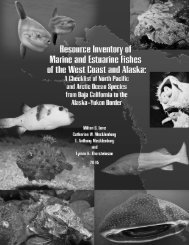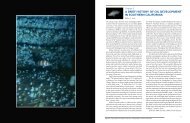Reproductive Ecology and Body Burden of Resident ... - The Love Lab
Reproductive Ecology and Body Burden of Resident ... - The Love Lab
Reproductive Ecology and Body Burden of Resident ... - The Love Lab
You also want an ePaper? Increase the reach of your titles
YUMPU automatically turns print PDFs into web optimized ePapers that Google loves.
Task 3: A Histological Examination <strong>of</strong> the Ovaries <strong>of</strong> Pacific S<strong>and</strong>dab,<br />
Citharichthys sordidus, Captured at Two Oil Platforms <strong>and</strong> Two Natural<br />
Sites in the Southern California Bight<br />
Milton S. <strong>Love</strong> <strong>and</strong> Stephen R. Goldberg<br />
Abstract<br />
A number <strong>of</strong> the 26 <strong>of</strong>fshore oil <strong>and</strong> gas platforms <strong>of</strong>f California may be nearing the end <strong>of</strong> their<br />
economic lives. Decisions as to the disposition <strong>of</strong> these platforms will be based on a number <strong>of</strong> parameters,<br />
including the biological role <strong>of</strong> the structures. One issue that has arisen is the possible contamination <strong>of</strong><br />
fishes living around platforms resulting from contaminants released during drilling <strong>and</strong> production. If significant<br />
contamination is occurring, it would be expected to impair the reproductive abilities <strong>of</strong> impacted<br />
fishes. One form <strong>of</strong> reproductive impairment is atresia, the abnormal reabsorption <strong>of</strong> oocytes that are destined<br />
to be spawned. Atresia has been widely used as an indicator <strong>of</strong> pollutant-related reproductive impairment<br />
in fishes. We examined the occurrence <strong>of</strong> atretic oocytes in Pacific s<strong>and</strong>dab, Citharichthys sordidus,<br />
collected from two <strong>of</strong>fshore platforms in the Santa Barbara Channel (B <strong>and</strong> Gilda) <strong>and</strong> from two natural<br />
reference sites (<strong>of</strong>f the east end <strong>of</strong> Santa Cruz Isl<strong>and</strong> <strong>and</strong> in mid-channel <strong>of</strong>f Rincon). While pronounced<br />
atresia was observed in a few fish at one natural site <strong>and</strong> one platform, there was no evidence <strong>of</strong> widespread<br />
pronounced atresia at any <strong>of</strong> the four sites.<br />
Introduction<br />
<strong>The</strong>re are 26 <strong>of</strong>fshore oil <strong>and</strong> gas platforms in California waters, many <strong>of</strong> which may be nearing the<br />
ends <strong>of</strong> their economic life spans. Following the decision by an operator to cease production, the process<br />
by which a decision is made as to the disposition <strong>of</strong> a platform is called decommissioning. This procedure<br />
may take into consideration the biological, sociological, <strong>and</strong> economic consequences <strong>of</strong> various decommissioning<br />
options, which range from leaving the entire structure in place through partial or total removal<br />
(Schroeder <strong>and</strong> <strong>Love</strong> 2004).<br />
Among the issues that need to be addressed in this process is the possible contamination <strong>of</strong> platform-dwelling<br />
organisms. A number <strong>of</strong> activities associated with the production <strong>of</strong> oil <strong>and</strong> gas result in<br />
the creation <strong>of</strong> contaminants. Drilling muds (used to lubricate drill bits), drill cuttings (the hard material<br />
brought up by the drill bit), the water associated with the petroleum produced (“produced water”), <strong>and</strong><br />
water used as coolant contain a variety <strong>of</strong> elements <strong>and</strong> compounds, including petroleum hydrocarbons<br />
<strong>and</strong> metals (Utvik 1999; Neff 2002; Steinberger et al. 2004). At least some <strong>of</strong> these elements <strong>and</strong> compounds<br />
are released into the water <strong>and</strong> may be deposited on the sea floor around these structures (Grant <strong>and</strong> Briggs<br />
2002; Phillips et al. 2006). While the acute toxicity <strong>of</strong> these materials varies considerably among both platforms<br />
<strong>and</strong> organisms (Utvik 1999; Grant <strong>and</strong> Briggs 2002), less is known about their potential chronic effects<br />
(Stephens et al. 2000).<br />
One issue to be addressed during decommissioning is the possible damage to fish reproduction if<br />
a structure is left in place. Pollutants such as heavy metals <strong>and</strong> chlorinated hydrocarbons have been linked<br />
to a range <strong>of</strong> physiological problems in fishes, including reproductive impairment (Hose et al. 1989; Cross<br />
<strong>and</strong> Hose 1988; Thomas 1989). One form <strong>of</strong> reproductive impairment linked to pollution is atresia, the abnormal<br />
reabsorption <strong>of</strong> oocytes destined to be spawned. Atresia has been used as an indicator <strong>of</strong> pollutantrelated<br />
reproductive impairment in fish living in the southern California Bight (Cross et al. 1984).<br />
71




